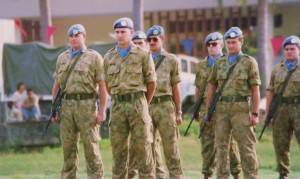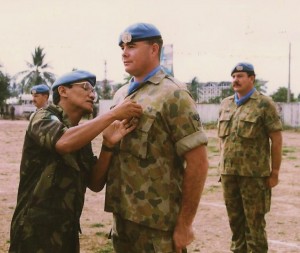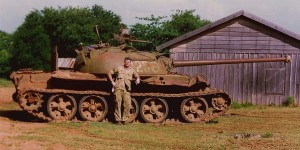Twenty-two years ago my older brother was deployed to war-torn Cambodia to help that country prepare for a free and fair election.
Last week as part of the Australia Day honours, he and his fellow members of the Australian Defence Force were finally honoured with a Meritorious Unit Citation for their courage and “sustained outstanding service in war-like operations”.
The prestigious award recognises their service as part of the United Nations Transitional Authority in Cambodia (UNTAC) from 1992 to 1993.
My brother, Gavin Lee, (pictured far left in the photograph below) had been married a mere two weeks and was a signaller in the Army with the rank of Corporal. He was part of the ADF’s Force Communications Unit and proudly wore his pale blue beret, identifying him as a member of the UN force.
Members of the Royal Australian Air Force and Royal Australian Navy were also deployed along with their counterparts from the Royal New Zealand Corps of Signals in what was then, and remains to this day, the United Nation’s most ambitious and biggest mission.
Cambodia had endured years of uncertainty and civil war, and survived Pol Pot’s homicidal reign of terror during which millions were killed. The ravaged nation was, in 1992, effectively, a country of warring factions.
That it took 22 years for the FCU to be recognised with the MUC is a story of tenacity, endurance and the never-take-no-for-an-answer attitude by a few good and true men, including of one of my brother’s comrades in arms, Paul Copeland, OAM.
The unit became, collectively, only the 24th to receive the MUC since it was introduced in 1991, and 913 members have been included on the nominal roll to receive the insignia. Though, realistically, the FCU would have been the fourth unit to receive the award after the RAN ships that served in the Gulf War of 1991 including HMAS Sydney, HMAS Brisbane and the Clearance Diving Team 3. Had the MUC been awarded at the end of the operation, it would have been the first for an Army commanded unit. No mean feat.
Why the delay? Somewhere along the way the unit, whose service was always designated as war-like, was wrongly awarded the Australian Service Medal for non-war-like service. Clearly, an error.
“The dangerous conditions were four warring factions that continually engaged each other in combat, despite the ceasefire process,” Copeland says. (For more information, click here.)
“The countryside was littered with millions of land mines. Many locals and some UN personnel were either killed or maimed by land mines, including UN vehicles driving on Anti-Tank mines.”
My brother, Gavin, knows first hand about those land mines. He was flagged down by panicked Cambodian villagers, gesticulating wildly at a little girl who had been left alone in the middle of a field. She was screaming in agony. The girl had triggered a landmine, thousands of which had been planted by enemy forces, that exploded beneath her tiny frame. The Cambodians were too frightened to rescue her.
Corporal Lee walked through the field and scooped up the child. He told me he had no idea the field was planted with live mines until he approached the girl and saw her wounds.
He had no option other than to methodically re-trace his footsteps out of the field back to his UN vehicle. He managed to keep the child alive during the harrowing 10kms drive to the nearest medical aide station, run by the French Foreign Legion. He delivered her to medics alive, but to this day has no idea if she survived.
That’s just one story.
(Picture: CPL Lee being awarded the United Nations Medal for UNTAC by the Indian Area Commander in 1993).
Other members of the FCU were fired upon or taken as prisoners of war by the Khmer Rouge. United Nations helicopters, clearly painted white with their black UN insignia, were repeatedly “painted” by surface-to-air missiles.
No doubt, a dangerous mission. Here’s a part of the official citation:
“Members of the Unit were deployed to 50 locations throughout Cambodia to operate the [communications] network. They worked for long periods without relief and were constantly under threat of violence from the warring parties. The hostilities, particularly prior to the election, specifically targeted United Nations personnel and the communications network. On many occasions communication facilities were operated while under threat from artillery, mortars and small arms fire. The Unit’s efforts and achievements allowed the United Nations Transitional Authority in Cambodia Headquarters to communicate with its components as they undertook preparations for what would be a successfully conducted election.”
Tragically, the legacy of that mission continues.
“We have seen an increase in our UNTAC veterans reporting with post traumatic stress disorder [PTSD], depression and other mental illnesses,” Copeland says. “A good number of them are now totally and permanently incapacitated [TPI] as a result of the trauma they experienced in Cambodia.”
Finally, though, war-like service and actions of the FCU was accurately upgraded in 1999 and the men and women who played such an integral role in shaping the future of Cambodia received the Australian Active Service Medal. But it wasn’t over for Copeland and Co.
He then was advised that the MUC had been “approved by the Chief of Defence Force, Admiral Chris Barrie, in October 2002…and [that] there was another nomination endorsed by Lieutenant General John Sanderson AC, who was the Australian Force Commander for UNTAC in 2008″.
Still, it took another 12 years until this January for the highly regarded citation to get official approval.
For his part, Lieutenant General Sanderson had previously made a speech commemorating the 60th anniversary of the Australian Defence Force’s role in international peace keeping and said the FCU in Cambodia was among the best of the best.
“UNTAC was the largest, most expensive and ambitious UN Peacekeeping Operation to date,” Sanderson said. “I was extremely fortunate to have an Australian Force Communications Unit… They were the most widely dispersed and deployed unit in the UNTAC Military Force and saw more action than any unit… They were the glue that held the Operation together.”
Which is why the long wait for the Meritorious Unit Citation is so sweet.
Copeland says it is “welcome recognition of such courage, service and sacrifice in one of the most dangerous countries on the planet at that time”.
Congratulations to all the men and women who can now wear the citation’s insignia (pictured above) with pride on their left chest alongside other campaign and service medals. You earned it.


